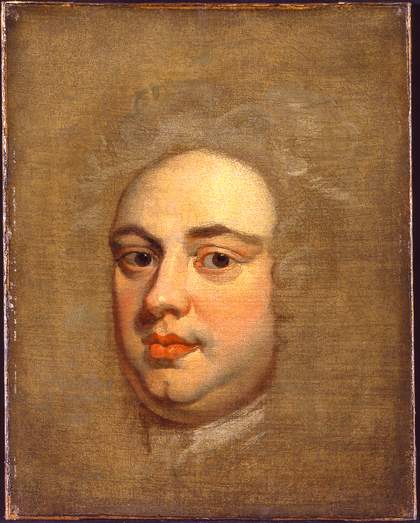
Fig.1
Attributed to Jonathan Richardson
Unknown Gentleman c.1730–40
Tate
T01894
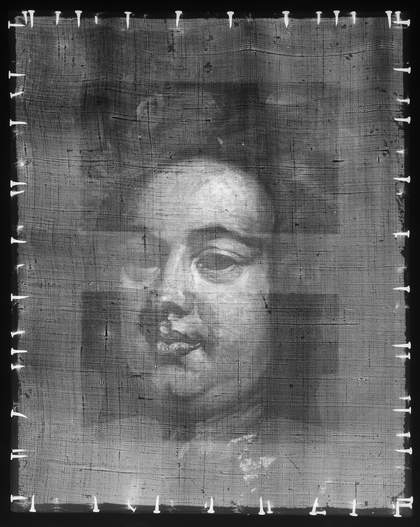
Fig.2
X-radiograph of Unknown Gentleman c.1730–40
This unfinished painting or study for a painting is in oil paint on canvas measuring 375 x 298 mm (fig.1). The support is composed of a single piece of plain woven canvas. The slubby threads are uneven in thickness and have an average weave count of 13 threads per square centimetre in both directions. The tacking edges are no longer extant but cusping is visible along the top and left-hand edges (fig.2).1 This indicates that the head would always have been in this position in relation to the top and left edges. It is very likely therefore that the painting was always meant to be this size and it is possibly a study for a larger portrait. Only the face, wig and neckcloth are painted. The painting has a double glue paste lining dating probably from the late nineteenth century.
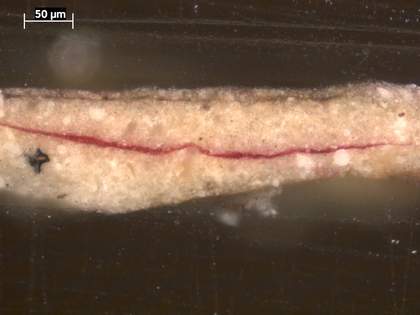
Fig.3
Cross-section of the background taken 169 mm from the top edge and 5 mm from the left, photographed at x320 magnification. From the bottom of the sample upwards: first coat of grey ground; animal glue size stained red with acid fuchsin applied to the section; second coat of grey ground; thin layer of dirt; modern retouching
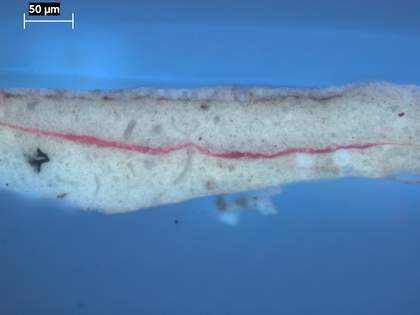
Fig.4
The same sample as in fig.3, photographed at x320 magnification in ultraviolet light
The ground is cool, pale grey, consisting of chalk, lead white, fine black (probably lamp black), earth colour, red lake on an aluminium-based substrate, ground glass and a trace of pipeclay all mixed together.2 The binding medium appears to be very lean oil; the ground is thinly bound and crumbly. It was applied in two coats separated by an unpigmented layer of animal glue size, which was confirmed when it was stained positively for protein with acid fuchsin (figs.3–4). This construction is commonly found in British paintings of the 1730s, 1740s and 1750s, and might suggest a colourman’s application. Another common feature of this period is the ground’s texture; microscopic ridges, some 2 or 3 to a millimetre’s width, run regularly across the entire canvas. In this instance they are horizontal; the direction varies from painting to painting but it is always consistent throughout each canvas support.
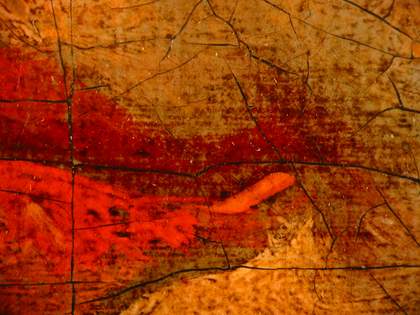
Fig.5
Photomicrograph at x8 magnification of the corner of the mouth, showing initial reddish brown painted drawing lines, underneath brighter, opaque red paint and with the flesh tone brought up close to it
The face has painted, dark red underdrawing composed of vermilion with a fine black and some red lake. It was left visible here and there in the face to help define the features (fig.5). Being red, this underdrawing is not rendered visible by infrared reflectography.
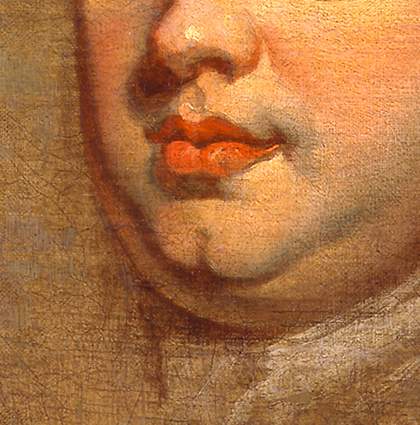
Fig.6
Detail of the face of Unknown Gentleman c.1730–40, showing greenish grey half shadows and the grey ground just visible above the upper lip line to help define it
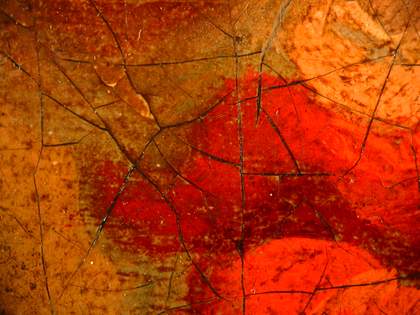
Fig.7
Photomicrograph at x8 magnification of the mouth, as in fig.6
The face is fully realised but the hair and collar were left vague on the unpainted, grey ground layer. The face is painted wet-in-wet. Thin, opaque, greenish-grey mixtures were used for the shadows and half-shadows, which have suffered some abrasion. The artist also left the grey ground visible to stand as half shadows around the features (figs.6–7). Both blue and green pigments were mixed into the darkest flesh tones for the darkest shadows. This can be seen in the shadows under the sitter’s chin but most strikingly in its cleft, which has a bold application of greenish paint (indigo containing) mixed wet-in-wet with a pink colour. Fine green verdigris was also mixed into the pale grey curls of the hair, which were also modified with the addition of vermilion and a little red lake.
The artist has used a varied palette to depict the range of colours including lead white, vermilion, red lake, yellow lake, indigo, verdigris, sienna, umber, cologne earth, red earth, black, chalk and ground glass.
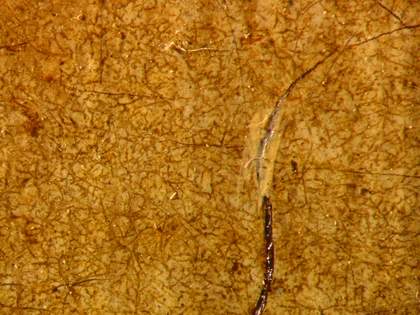
Fig.8
Photomicrograph at x12.5 magnification of the impression of facing paper in the grey hair. There is a modern retouching on the crack to the right of centre
The painting has an extensive brittle fracture crack pattern, although the heavy lining has corrected any raised paint or flaking that may have occurred in the past. Lining also seems to have contributed to an unusual surface phenomenon. The surface of the painting displays a fine, fibrous network of paint deformation caused by an aggressive facing treatment with paper during lining (fig.8). The paint took up the impression of the facing material while it was exposed to high levels of heat and moisture during that process.
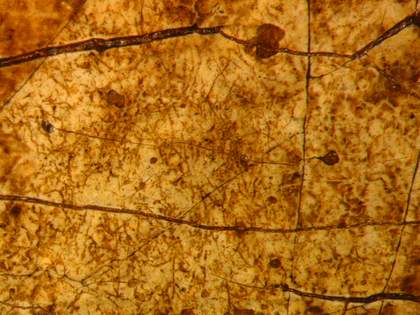
Fig.9
Photomicrograph at x1.6 magnification of the collar, showing the impression left by the facing paper, and also tiny hollows where lead soap aggregates, protruding through the paint, have been removed by age and wear
In very close examination the painting displays protruding lead soap aggregates in some areas.3 These appear to have been worn away or eroded (fig.9). These tiny, spherical protrusions are confined to the thick whites and flesh paints and do not seem to be associated with the ground.
There are several small retouchings concealing losses in the face, which now no longer colour match. There are also more extensive areas of retouching in the background, which are matt and discoloured. Many of these have a stripey appearance.
The painting has a natural resin varnish, which has yellowed, giving the background a green appearance, and the interstices of the canvas weave retain brown residues of an older varnish. This is particularly noticeable in the face.
March 2020
